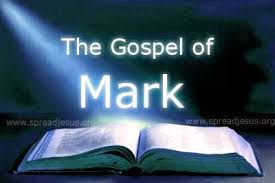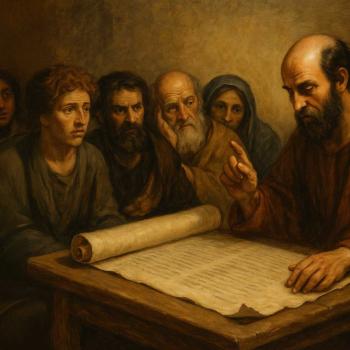 Early church father Papias–the bishop of Hierapolis who lived at the turn of the first century–has been an important person in trying to establish data about gospel origins. Papias reportedly wrote five books, of which some bare fragments have survived. Later church fathers Irenaeus and Eusebius wrote about a connection between Papias and the Apostle John. Scholars debate whether or not these texts mean Papias knew the Apostle John or that he merely knew an elder named John who knew the Apostle John.
Early church father Papias–the bishop of Hierapolis who lived at the turn of the first century–has been an important person in trying to establish data about gospel origins. Papias reportedly wrote five books, of which some bare fragments have survived. Later church fathers Irenaeus and Eusebius wrote about a connection between Papias and the Apostle John. Scholars debate whether or not these texts mean Papias knew the Apostle John or that he merely knew an elder named John who knew the Apostle John.
Despite all of this, in an extant fragment of Papias’ writings he says of John Mark–who is mentioned in Acts 12.12, 25, and 15.37 and is believed to have written the Gospel According to Mark–“Mark having become the interpreter of Peter, wrote down accurately whatsoever he remembered” (ANF: First Series, 1.6.6). It is elsewhere said that Mark did this when he accompanied Peter on a preaching tour through Italy.
This historical claim by Papias is partly why New Testament (NT) scholars think there was very much literary dependence in the writing of at least the gospels of Matthew and Luke (see Luke 1.1-3). For this reason, most NT scholars believe in the Two Source Hypothesis (2SH). It is a theory about the origin of the gospels of Matthew and Luke. This theory is based on what is called “Markan priority,” meaning the Gospel of Mark was written first and that it and Q were later used in the compiling of the gospels of Matthew and Luke. Q is their abbreviation for the German word quelle, meaning “source.” Q refers to a hypothetical, written collection of what were primarily sayings of Jesus. But there is no literary evidence for Q. Despite its wide scholarly support, some scholars question that Q ever existed. Plus, it cannot be proved that the Gospel of Mark was the earliest written of the synoptic gospels.
I doubt the Two Source Hypothesis. But I’m far from being an authority on what is an extremely complex subject–the origin of the NT gospels. However, in the compilation of my single narrative harmony of all four NT gospels that I compiled in the NIV and that is included in my book, The Gospels Interwoven, the familiarity I gained from this meticulous work in comparing these gospels caused me to doubt 2SH.
Also, I think it is questionable that John Mark depended on Peter in writing the Gospel of Mark, which impinges on the likelihood of 2SH, for the following three reasons, with two of them being major reasons (scripture quotations are from the NRSV):
- The foremost synoptic pericope about Peter is when Jesus asked his disciples who is was. All three synoptists record it, though Mark and Luke provide a brief account (Matt. 16.13-20; Mark 8.27-30; Luke 9.18-20). Matthew says Peter answered, “You are the Messiah, the Son of the living God” (Matt. 16.16; cf. Mark 8.29; Luke 9.20). But only Matthew adds that Jesus then said, “Blessed are you, Simon son of Jonah! For flesh and blood has not revealed this to you, but my Father in heaven. And I tell you, you are Peter, and on this rock I will build my church, and the gates of Hades will not prevail against it. I will give you the keys of the kingdom of heaven, and whatever you bind on earth will be bound in heaven, and whatever you loose on earth will be loosed in heaven” (Matt. 16.17-19). This is the highlight of Peter’s experience with Jesus during his ministry. Yet both Mark and Luke have not included this saying by Jesus to Peter. I doubt that Peter would have preached many things about Jesus and omitted this most important encounter between Jesus and himself. The Roman Catholic Church regards it as most important and the basis of their papacy doctrine.
- The gospels of Matthew, Mark, and John record an incident in which Jesus walked on water at night near where his disciples were rowing a boat in a storm on the Sea of Galilee (Matt. 14.24-33; Mark 6.47-52; John 6.16-21). When the disciples first saw Jesus walking on the water, they thought it was a ghost and became frightened. But Jesus said to them, “Take heart, it is I; do not be afraid” (Matt. 14.27/Mark 6.50; cf. John 6.20). The gospels of Mark and John then merely say Jesus got into the boat. But Matthew adds before this, while Jesus was still on the water, “Peter answered him, ‘Lord, if it is you, command me to come to you on the water.’ He said, ‘Come.’ So Peter got out of the boat, started walking on the water, and came toward Jesus. But when he noticed the strong wind, he became frightened, and beginning to sink, he cried out, ‘Lord, save me!’ Jesus immediately reached out his hand and caught him, saying to him, ‘You of little faith, why did you doubt?’” (Matt. 14.28-31). This may be the second most important event that Peter experienced with Jesus during his ministry. And since it was a nature miracle of such astounding magnitude, I think it very doubtful that Peter would have omitted preaching this when Mark accompanied him.
- Of lesser importance is the time when Jesus spoke to his disciples about defilement. Only Matthew and Mark record it (Matt. 15.10-20; Mark 7.14-23). At that time, Jesus refuted the Pharisees’ view that eating certain things defiles a person (Matt. 15.10-14; Mark 7.14-16). Matthew then reports, “But Peter said to him, ‘Explain this parable’” (Matt. 15.15). Mark, however, only says, “his disciples asked him about this parable” (Mark 7.17). Jesus then explained it to them. Assuming Matthew’s more precise specification is correct, I doubt Peter would have said Jesus’ “disciples” asked this question rather than “Peter” himself if Mark’s gospel is based on Peter’s reminiscences.












